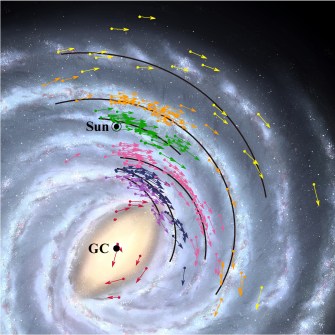Key Takeaways:
- New data suggests Earth is 2,000 light-years closer to the supermassive black hole Sagittarius A* at the galaxy’s center.
- This finding is due to better modeling of the Milky Way using data from the Japanese VERA project.
- VERA uses radio telescopes across Japan to map the galaxy’s 3D structure with high resolution.
- The new model places the galactic center, and the supermassive black hole, at 25,800 light-years from Earth (previously thought to be 27,700).
- Earth’s speed orbiting the center is also slightly faster than previously thought, at 227 km/s compared to the prior estimate of 220 km/s.
If you think Earthly matters haven’t been going well already, it also turns out that our planet is much closer to the supermassive black hole at the center of the galaxy than we imagined. Researchers have been able to improve the modeling of the Milky Way Galaxy thanks to new observation data, which indicates that Earth is moving closer to the supermassive black hole Sagittarius A* by 2,000 light years and at a speed of 7 km/s (~16,000 mph).
The more accurate data came from 15 years of data collected by the VERA project, a Japanese radio astronomy project. VERA is an acronym for Very Long Baseline Interferometry and VLBI Exploration of Radio Astrometry. The project started in 2000 and has the goal of mapping the Milky Way’s three-dimensional velocity and spatial structures.
Utilizing interferometry, VERA collects and combines data from radio telescopes located throughout the Japanese archipelago. This technique allows the project to get astounding resolution, as good as a telescope with a 2300 km diameter. If a penny from the United States was accidentally left on the Moon, the measurement would be sharp enough to distinguish it at this exact resolution of 10 micro-arcseconds.
The astronomers assembled a position and velocity map of the Galaxy with a new center thanks to observations recently made by other researchers and the VERA Astrometry Catalog. Everything in the galaxy revolves around this point.

The 224 objects that were used to model the Milky Way Galaxy have their position and velocity data indicated by arrows on this map. The Galaxy’s spiral arms are indicated by the solid black lines. Groups of objects that belong to the same arm are reflected by color, and a simulation image serves as the background.
The new map claims this center, along with the supermassive black hole it contains, is about 25,800 light-years away from Earth. This is notably closer than the 27,700 light-years that the International Astronomical Union set as the official distance in 1985.
The planet’s velocity was also distinguished by the new map’s velocity component, which indicated that it is orbiting the Galactic Center at a speed of 227 km/s. Compared to the previous “official” speed of 220 km/s, that is 7 km/s faster.
After that, VERA focuses on other objects, particularly those near the supermassive black hole at the center of the galaxy.


